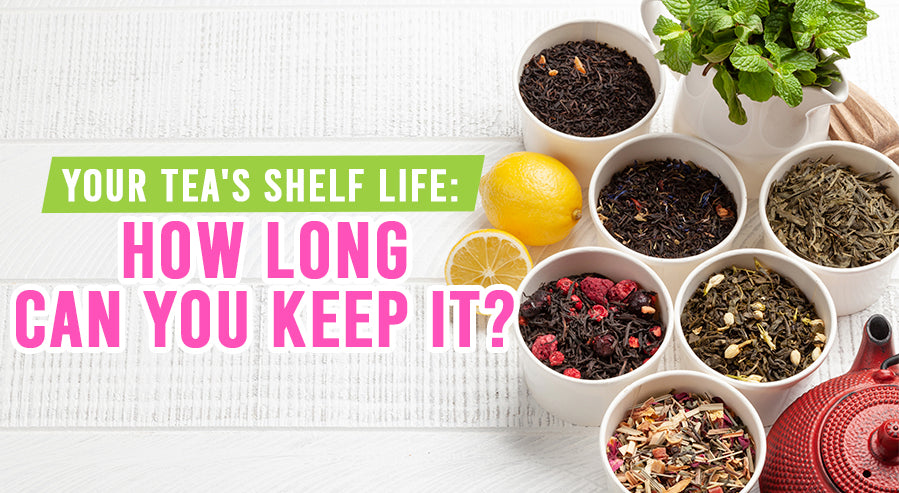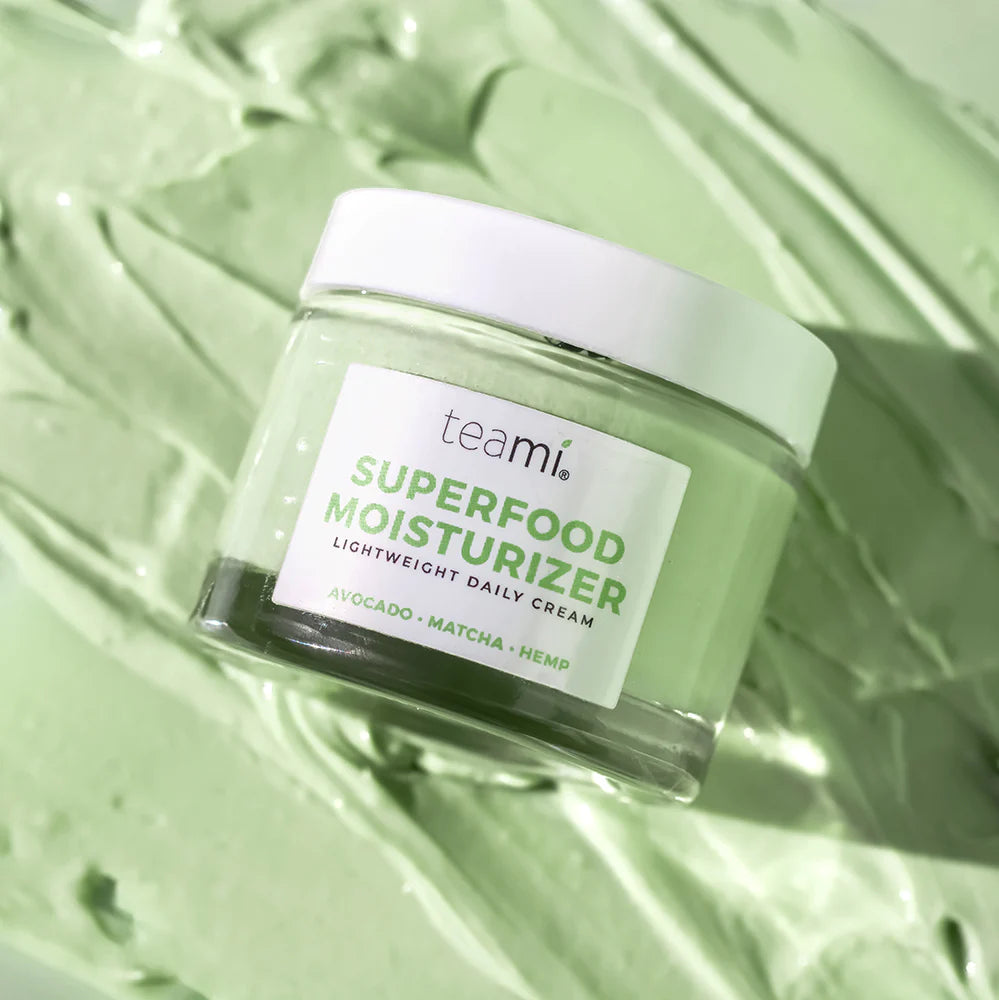Your Tea's Shelf Life: How Long Can You Keep It?

We've all been there. You stumble upon an old favorite tucked away in your pantry, and the anticipation builds as you steep those leaves - only for disappointment to strike with that first sip.
The sad truth is, much like any other food product, teas have their expiration dates too. But don't worry! In this guide, we're going deep into everything from understanding why teas lose freshness over time to tips on proper storage.
From exploring the lifespan of different types to diving into how brewing methods might change their shelf life, we've got it covered. We're not stopping there, though - let's also get into the nitty-gritty about organic versus non-organic teas and loose leaves against bagged ones.
The Science Behind Why Tea Loses Its Freshness Over Time
Tea, such as other edibles, can become stale with time. This is largely due to two scientific phenomena: oxidation and moisture absorption.
Oxidation happens when tea leaves come into contact with air. Oxygen reacts with the organic material in the leaves, causing them to darken and change flavor, often resulting in a stale taste.
This process starts as soon as the leaf is plucked from the tree but accelerates once it's exposed more directly to oxygen during processing or improper storage. It's this same reaction that causes an apple slice to brown after being cut.

Besides oxidation, teas are also prone to absorbing moisture from their surroundings. Humidity can wreak havoc on your precious tea by promoting mold growth or causing clumping, which leads to uneven steeping.
In fact, according to research published in the Journal of Food Engineering, high humidity conditions have a negative impact on tea quality because they accelerate chemical reactions within the leaf itself.
Last but not least are light and temperature influences. Exposure to direct sunlight speeds up oxidative processes, making your brew taste bitter faster than you'd want. On top of that, higher temperatures can spur bacterial growth – another no-no for keeping your tea fresh.
So, understanding the science behind why tea loses its freshness over time is key to making sure your favorite blend stays flavorful for as long as possible.
How to Properly Store Your Tea for Freshness
Keeping your tea fresh is all about storage. Beneath the surface, it may seem complicated; however, proper storage is not a difficult task. Here are some practical tips and guidelines that will help.
Your tea leaves hate light. They're like vampires of the plant world. Store your tea leaves in a dim area where they won't be exposed to any sunlight. Dark teas, ironically enough, suffer the most under bright lights.
Air isn't much better either because oxygen can speed up the degradation process of your precious brews. To keep air out, use an airtight container or resealable bag.

If you've ever left chocolate on the dashboard during summer (don't judge.), you know heat melts things fast. Well, guess what? It does something similar to your tea – spoiling its flavor faster than normal room temperature would allow.
The type of container matters, too. Use containers made of materials such as ceramic or tin which do not react with tea leaves. Certain plastics and metals may impart unwanted flavors into your favorite blends.
Last but definitely not least - avoid storing teas in fridges or freezers unless they're sealed so tightly they could survive deep space travel.
Remember, tea is not just a beverage but an experience that starts with storage and ends in your cup. So, store wisely to enjoy the best flavors possible.
The Shelf Life of Different Types of Tea
Tea is a beloved drink around the globe, yet its shelf life may differ significantly depending on what kind it is. Let's break down how long different types can last when stored properly.
Black and oolong teas have a longer shelf life than other varieties when stored correctly. They'll keep their flavor for up to two years if stored in an airtight container away from light and moisture. Healthline supports this with detailed information about tea storage practices.
In contrast, green and white teas have shorter lives because they're less oxidized. Typically, they maintain freshness for 6-12 months under optimal conditions. The Spruce Eats, another trusted source of food knowledge, has more insights into preserving these delicate flavors.

Pu'er tea breaks the mold as it actually improves with age, like fine wine. This fermented Chinese variety can be aged for many years without losing quality—some even claim that it gets better over time. You'll find fascinating tales of century-old Pu'er teas still being enjoyed today at Serious Eats.
Remember, the key to maintaining tea freshness is proper storage. So whether you're a fan of black or green or an adventurous Pu'er drinker, treat your teas right, and they'll reward you with delightful flavors.
Signs Your Tea Has Gone Bad
Your tea's taste should be fresh and vibrant. But when it goes stale, you'll notice a few telltale signs. Understanding these signs can help prevent an unpleasant brewing experience.
A distinct change in aroma is one of the first indicators that your tea has gone bad. Freshly stored tea leaves or bags have a rich smell indicative of their flavor profile—be it floral, fruity, earthy, or spicy.
If this fragrance fades significantly or smells musty over time, consider this a red flag.
The proof is truly in the tasting. If your cuppa tastes bland despite correct brewing techniques and proportions—it's probably past its prime. Unlike wine, tea doesn't improve with age.

Mold on your teas? Dampness could be the culprit here. Tea absorbs moisture from its surroundings, which encourages mold growth—a sure sign of spoilage. Ensure that they are kept dry and fresh by storing them correctly.
Last but not least is the appearance check. Discoloration can also hint at compromised quality; good quality loose-leaf green teas, for example, maintain bright color even after storage, while poor ones may turn duller over time.
Remember, folks - every sip counts towards our wellness journey, so let's make each one count by ensuring freshness.
How Brewing Method Affects the Expiration Date
The brewing method you use can make a difference in how long your tea stays fresh. Different methods expose tea to various elements like air and water, which could accelerate or slow down its aging process.
Teatulia's guide on brewing tea explains that steeping loose-leaf teas directly in hot water allows for maximum flavor extraction but might also lead to quicker oxidation if not consumed promptly.
If you're looking to keep your brew fresher for longer, cold brew might be an interesting avenue to explore. Cold-brewed teas are steeped at room temperature or refrigerated conditions over several hours, reducing exposure to heat, which is known as a catalyst for oxidation.

You may love traditional teapots for their aesthetic charm, but remember they can potentially speed up your tea's expiration date. This happens because these pots often let more oxygen reach the leaves during infusion compared with other closed systems like an infuser basket or French press.
I once left my favorite Oolong blend sitting too long in a teapot, only to find out later it had lost much of its floral notes. Lesson learned: enjoy your teapot brews promptly.
As a tea lover, I've found that understanding how brewing methods affect my teas' shelf life has been crucial in making sure every cup is as delightful as it can be.
Impact of Organic Vs. Non-Organic Teas on Shelf Life
When it comes to tea, the organic versus non-organic debate isn't just about taste or health benefits; shelf life also enters the picture.
The consensus is that both types of teas generally last for a similar duration when stored correctly. But there are nuances worth exploring.
Pesticides used in non-organic tea farming might prolong freshness due to their preservative properties. Studies show they can help keep insects at bay, reducing damage and potentially extending shelf life.
In contrast, organic teas are pesticide-free, which means they rely more heavily on proper storage methods to maintain quality over time.

All teas undergo natural deterioration processes like oxidation and moisture absorption. These affect both organic and non-organic varieties similarly because these changes aren't linked with whether a tea is grown organically or not - rather, they're tied to how well you store your brew.
While science doesn't provide a clear winner between organic and non-organic tea longevity, some people argue that organic blends retain flavor better over time since no artificial elements interfere with their pure nature. Remember, though, taste varies from person to person, so try different ones out yourself.
So, when choosing between organic and non-organic teas from Teami, consider factors like flavor preferences, health considerations, and storage practices. They all contribute to how long your tea will last.
Loose Leaf Vs. Tea Bags – Which Lasts Longer?
Are you wondering if there's a distinction between the shelf life of loose-leaf tea and bagged tea? Well, the answer is yes. Generally, loose-leaf teas tend to last longer.
The key lies in the size of the leaves. Loose leaf teas have larger pieces, which means they are less exposed to air compared to smaller fragments found in most bags.
But that doesn't mean you should toss your tea bags just yet. Proper storage can extend their freshness, too. Both types need cool, dry places away from light and strong odors.
In general, bigger leaves retain flavor for more time because they have less surface area exposed to oxygen; less oxidation keeps them fresher for longer periods than smaller cut ones like those often found inside teabags.

This isn't an absolute rule, though: quality also matters—a top-notch bagged blend could outlast lower-grade loose leaves.
Different types of teabags, including paper, silk, or plastic materials, affect how long your tea stays fresh as well.
Paper bags may absorb moisture faster, leading to quicker degradation, while nylon or silk pouches generally offer better protection against external factors, thereby helping maintain taste over time, but may not be as eco-friendly.
So, the choice between loose-leaf and bagged tea depends on your preference for flavor longevity, convenience, environmental impact, and more. In any case, proper storage is key to keeping both at their best.
Finding the Right Blend
You are now an expert in maximizing the freshness of your favorite teas by understanding their shelf life and how to store them properly. The science behind why tea loses its freshness, like oxidation and moisture absorption, isn't just trivia—it's practical knowledge that'll help you make the most of your favorite brews.
We've dived deep into topics such as proper storage techniques for teas and examined different factors influencing their shelf life. We learned about telltale signs indicating if your tea has gone bad and also explored how brewing methods can impact your tea's expiration date.

You may be wondering where you can apply all this newfound wisdom. You need look no further. We have an amazing variety of high-quality teas perfect for any occasion or mood.
Our unique Profit Tea Blend, designed with natural ingredients like Goji Berries and Nettle Leaf, is fantastic for those looking for holistic wellness benefits. If weight management is on your agenda, consider trying out our specially crafted Skinny Tea Blend.
In need of some extra energy? Our invigorating Energy Tea Blend could be just the ticket. But that's not all; we at Teami offer many more teas tailored to different needs and preferences.
So there you have it—a guide to prolonging your tea's shelf life with a little help from science and some delicious suggestions for your next cuppa.
Do you have any questions about tea shelf life, how to properly store your tea, our various tea blends, or anything else we discussed in this article? If so, please feel free to let us know at any time, and we'll gladly answer any questions you may have! Additionally, if you've already tried one of our teas, what were your thoughts? We'd love to hear what you thought about your purchase!
Subscribe to our Newsletter
Subscribe to our newsletter and get 10% off your first purchase
 Instagram
Instagram



